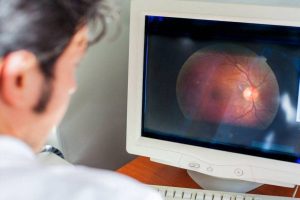Diabetic retinopathy is the leading cause of vision loss among people with diabetes.
If you have been diagnosed with diabetes, it is critical to ensure that your blood sugar levels are under control and you are closely monitored by your eye doctor.
The stages of vision loss
Diabetic retinopathy occurs in four stages, though symptoms generally go unnoticed until the disease has progressed to a more advanced stage.
Annual eye exams are strongly recommended for people diagnosed with diabetes, or those at risk of developing diabetic retinopathy.
Stage 1: Mild non-proliferative diabetic retinopathy (NPDR)
Mild nonproliferative retinopathy, also called Background retinopathy, is the earliest stage of the disease. During this stage, a high concentration of blood sugar in the retina causes the production of microaneurysms, or bulges in the tiny retinal blood vessels.
These microaneurysms may later rupture and bleed, causing “dot-and-blot” hemorrhages in the retina.
During this early stage, vision problems are unlikely to affect your daily life, and you may not even notice any visual changes. However, during an annual eye exam, your eye doctor can detect signs of this early stage and will discuss ways in which you can prevent the progression of the disease— namely: keeping your blood sugar, blood pressure, and cholesterol under control.
It is crucial to emphasize the importance of annual eye examinations, especially once you have been diagnosed with NPDR, as there is a five percent chance that the disease can progress to the second stage within one year.
A diagnosis of NPDR in both eyes can increase your risk of rapid disease progression from the first to the third stage within three years.
Stage 2: Moderate non-proliferative retinopathy (NPDR)
Moderate nonproliferative retinopathy, also called pre-proliferative retinopathy, is the second stage of the disease.
During this stage, the retinal blood vessels begin to swell and their integrity begins to diminish, impacting blood circulation throughout the retina.
During this stage, visual symptoms may begin to present and may even lead to a condition called diabetic macular edema (DME). If blood leaks into the macula located in the center of the retina, the blood and fluid buildup can cause the macula to swell, causing loss of central vision and vision for fine details.
Diabetic macular edema affects more than half of patients with diabetic retinopathy.
Once a diagnosis of moderate NPDR is confirmed, it is recommended to have follow up eye exams every three to six months, as the risk for disease progression to the third stage within one year is between 12 to 27 percent.
If you have diabetes, contact an eye doctor near you, who can diagnose and discuss the best treatment options.
SEE RELATED: 4 Ways Diabetes Can Affect Your Vision
Stage 3: Severe non-proliferative retinopathy (NPDR)
Severe nonproliferative retinopathy is the third stage of the disease. During this stage the blood vessels are further damaged, leading to further decreased blood circulation throughout the retina.
As a result, scar tissue may form on the retina, and trigger the retina to produce new blood vessels.
During this stage, blurry vision and dark spots, also called ‘floaters’ may occur if blood vessels are completely blocked. This is called a macular ischemia.
At this stage, the risk of permanent vision loss is high, though treatment may prevent further vision loss.
Once a diagnosis of severe NPDR is confirmed, it is recommended to have follow up eye examinations every three to six months, since the risk of progression to the final stage of diabetic retinopathy within one year increases to 52 percent.
Stage 4: Proliferative diabetic retinopathy (PDR)
Proliferative diabetic retinopathy is the last and most severe stage of the disease. During this stage, neovascularization will occur, causing abnormal blood vessels to grow in the retina.
These new blood vessels are abnormally thin and weak and prone to breaking. If they break, it can lead to bleeding into the vitreous, or the gel-like fluid that fills the eye, and cause retinal scarring, severe vision difficulties, and even blindness.
Retinal detachment is a complication that can occur at this stage, if the retinal scar tissue shrinks and pulls the retina away from the back of the eye. This complication can cause permanent central and peripheral vision loss.
Once a diagnosis of this stage has been confirmed, your eye doctor will want to monitor you on a monthly basis until the disease stabilizes.
Treating diabetic retinopathy
To effectively treat diabetic retinopathy and prevent vision loss, it is essential to have a team of doctors and specialists on your side.
Eye doctors, retina specialists, primary care physicians, and endocrinologists all play an important role in protecting your ocular health and vision. Strong communication between your doctors will enable you to receive optimal treatment, and increase your chances of protecting your vision.
If you have been diagnosed with diabetes, the best way to protect your vision is to keep your diabetes under control and your body in optimal health. Just as important, is attending annual eye exams and any follow up exams recommended by your doctor.
LEARN MORE: Guide to Eye Conditions
Schedule an appointment with an eye doctor for a diabetic eye exam, and to discuss any questions you may have about treating your eye condition.
Protecting your health can help you to protect your vision, and allow you to enjoy a lifetime of happiness.


